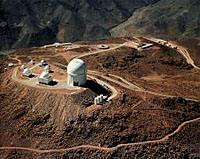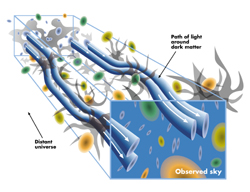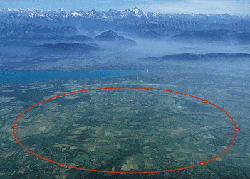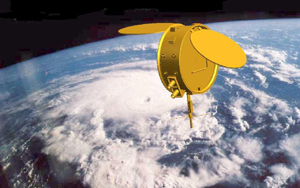 |


NSF Support for International Facilities
The Foundation is the primary supporter of a number of facilities
that are predominantly international in character. Some of
these facilities are located overseas, in which cases there
are explicit frameworks for multinational support, with foreign
contributions often provided in-kind. In those cases where
the facilities are located on U.S. soil, construction and
operating costs are most often (but not always) borne by the
Foundation.The Gemini North telescope dedicated on June 25,
1999, near the summit of Hawaii's Mauna Kea, is an example
of international cost-sharing of a facility on US soil. (NSF
Media Advisory PA/M 99-16)
Overseas Facilities
The international facilities supported by NSF/MPS in the
Astronomical Sciences include:
|

|
NSF is responsible
for the design, development, and construction of facilities
for ground-based astronomy research. An early example is the
Cerro Tololo Interamerican
Observatory (CTIO) constructed in Chile more than 25 years
ago. Since such facilities are increasingly complex and costly,
it is more and more common to seek partnerships, including international
ones, to enhance scientific, technical, and educational value
and increase cost effectiveness.
CTIO is operated by the
Association of Universities for Research in Astronomy Inc.
(AURA), under a cooperative agreement with NSF/MPS as part
of the National Optical Astronomy
Observatory (NOAO); AURA also is the operating agency
for the US portion of the Gemini Observatories.CTIO has annual
operating costs of about $6.5 million.
|

Cosmic shear: the light from distant galaxies is distorted
by dark matter. |
Astrophysicists announced in the May 11, 2000 issue of Nature.
the first observations of cosmological shear, an effect predicted
by Einstein's theory of relativity. The discovery casts light
on the distribution of the dark matter that makes up much
of the universe. Using CTIO and a method known as weak gravitational
lensing, the scientists were the first to map the distribution
of dark matter over large swaths of the sky. (NSF Press Release
00-29)
NSF/MPS serves as the executive agency for the Gemini
Observatory, an international project with seven partner
nations (the U.S., the UK, Canada, Australia, Chile, Brazil
and Argentina).
The Gemini Observatory consists of two 8-meter telescopes,
one located at Mauna Kea, Hawaii, (Gemini
North) and Cerro Pachón in central Chile (Gemini
South), and hence provides full coverage of both hemispheres
of the sky. Both telescopes incorporate new technologies that
allow large, relatively thin mirrors under active control
to collect and focus both optical and infrared radiation from
space. Gemini North began science operations in mid-2000 and
Gemini South about a year later.(NSF Media Advisory PA/M 99-16)
|
 This
image of the Circinus Galaxy was taken with
NOAO's Abu infrared camera during testing at the Gemini
South telescope. This
image of the Circinus Galaxy was taken with
NOAO's Abu infrared camera during testing at the Gemini
South telescope.
Under the Gemini
Fellowships program, postdoctoral scholars from the Gemini
partner countries of Argentina, Brazil, and Chile are brought
to US institutions on research fellowships. In FY2000 AURA
initiated a program,
in cooperation with Fondacion Andes, to provide opportunities
for Chilean graduate students to pursue doctoral degrees in
the US.
|
|
NSF/MPS is also involved in the Atacama
Large Millimeter Array (ALMA) project, a developing international
partnership with the European community, to place a new radio
facility in northern Chile. Potential future partners are
Canada and Japan. NSF provided funds for design and development
of the facility for 3 years. The project is preparing to move
into the last year of design and development before project
construction. The European partnership, should the project
move forward, will provide 50% of total project funding.

ALMA conceptual image courtesy of the European Southern
Observatory (ESO) |
NSF/MPS, in partnership with the Department of Energy, is
involved in the development of a major international high
energy physics project, the Large
Hadron Collider (LHC), that will be located at CERN(European
Laboratory for Particle Physics) in Geneva, Switzerland.
The LHC is an accelerator which brings protons and ions into
head-on collisions at higher energies than ever achieved before.
This will allow scientists to penetrate still further into
the structure of matter and recreate the conditions prevailing
in the early universe, just after the "Big Bang".
|
|
The LHC will be built astride the Franco-Swiss
border west of Geneva, at the foot of the Jura mountains,
in front of the Alps. Support for this project will be provided
by several European countries and the US. NSF and the DOE
would contribute to the construction of two detectors for
this facility.
|
 |
|
Another example of the NSF/MPS role in funding large detectors
is the Pierre Auger cosmic
ray detector project. This is a multinational effort in which
NSF/MPS and DOE are contributing equally to the construction
costs. The US costs will be $15 million, about 15% of the
total. NSF and DOE share the responsibilities for oversight
of the US part, with neither agency designated as lead. NSF-supported
researchers are leading this project.
The Center for
Astrophysical Research in Antarctica (CARA) is a consortium
of US universities run from the University of Chicago. CARA
is an NSF Science and Technology Center (STC). The STC Program
is administered through the Office of Integrative Activities
(OIP) at NSF. The activities of CARA include the siting of
telescopes in Antarctica. CARA is funded and managed by NSF/OPP.
|
|
The photo shows the Viper Telescope (operated by CARA) at
Amundsen-Scott South Pole Station.
In 1998, researchers from Carnegie Mellon University, using
the Viper microwave telescope made a crucial measurement of
cosmic background radiation that may help science to settle
a fundamental question of whether the universe will expand
forever or collapse back upon itself. (NSF Press Release 98-88)
CARA
collaborates and shares instrumentation with
The Joint Australian Centre for Astrophysical Research in
Antarctica (JACARA), and works with UK and German astronomers.
|
|
The Cape
Roberts Project, supported by NSF/OPP, is an international
ocean-floor drilling program aimed at recovering paleoenvironmental
records from the time when ice sheets were just showing up
on Antarctica through the time when the ice sheets became
basically a permanent feature. In 1998, the first evidence
of large volcanic eruptions that shook Antarctica around 25
million years ago was discovered in rock cores retrieved from
the seabed under the auspices of the Project. (NSF Press Release
98-78)
|
 |
The Cape Roberts Project involves 7 countries (US, New
Zealand, Italy, UK, Germany, Australia, and the Netherlands).
The drilling was completed in FY2000, but science cooperation
is ongoing and continues through FY 2001. |
|
|
OPP has a myrid of international collaborations on a wide
variety of scales. For the Antarctic Program, the U.S. Antarctic
Program, 1999-2000
report captures something of this extensive international
partnering. Formal mechanisms include the Council
of Managers of National Antarctic Programs (COMNAP, a
U.S. initiative, administered by the American Geophysical
Union). OPP has also been extensively involved in Arctic
Council activities. This high level intergovernmental
forum addresses environmental protection and sustainable development
in the Arctic region. OPP participates in the Arctic
Climate Impact Assessment (ACIA), an international multi-year
program to assess the impact and effects of climate change,
including environmental, human health, social and economic
impacts.
The research and education facilities of the Organization
for Tropical Studies (OTS) in Costa Rica receive support
from NSF/BIO. OTS is a nonprofit consortium of 64 universities
and research institutions in the US, Costa Rica, Perú, Canada,
South Africa, México and Australia. OTS provides graduate,
undergraduate and professional training, facilitates research,
maintains three biological stations in Costa Rica, participates
in conservation activities and conducts environmental education
programs.
International Research Centers and Facilities
in the United States
All NSF-supported research facilities in the United States
are open to visiting scientists and students from other countries.
Some facilities, however, are explicitly committed to international
service, often having institutional agreements and arrangements
with partner institutions in other countries.
Examples of such facilities are:
The NSF/GEO National Center
for Atmospheric Research (NCAR) engages in a number of
collaborative programs involving atmospheric research institutions
in Canada, Germany, Australia, and Russia. The Annual
Scientific Report for 2000 serves to provide a sense of
the breadth of recent collaboration.
ELDORA (ELectra DOppler RAdar) is an airborne, dual beam,
meteorological research radar developed jointly at NCAR and
the Centre de Recherches en Physique de L'Environnement Terrestre
et Planetaire (CRPE), France. The largest single instrument
ever developed at NCAR, ELDORA mounted aboard Electra aircraft
tracks tornadoes and the thunderstorms that spawn them.
COSMIC
is the Constellation Observing System for Meteorology, Ionosphere
and Climate, a joint U.S.-Taiwan project. This experimental
program uses a constellation of six micro-satellites to provide
the data derived from the Global Positioning System (GPS)
for research in meteorology, ionosphere and climate.
 This
proof-of-concept experiment is managed by the NSF-supported
University Corporation for Atmospheric Research (UCAR), with
additional US support from NOAA, NASA, USAF, and ONR. The
National Science Council (NSC) of Taiwan provides a large
share of the support for this project. This
proof-of-concept experiment is managed by the NSF-supported
University Corporation for Atmospheric Research (UCAR), with
additional US support from NOAA, NASA, USAF, and ONR. The
National Science Council (NSC) of Taiwan provides a large
share of the support for this project.
NSF/BIO supports the
Arabidopsis Biological Resource Center (ABRC) at Ohio
State University (See "Global Scale
Projects" section in this Report) which serves a worldwide
research community by providing collection, preservation and
distribution of seeds, and DNA clone and library storage and
DNA clone distribution services. The ABRC database functions
and ordering system are incorporated into TAIR
, a searchable relational database.
|
|
The NSF/MPS Laser Interferometer Gravitational-Wave Observatory
(LIGO) is a facility dedicated to detection of cosmic gravitational
waves and the harnessing of these waves for scientific research.
It consists of two widely separated installations -- one in
Washington and the other in Louisiana -- operated as a single
observatory.
LIGO is being built by the California
Institute of Technology (Caltech) and the Massachusetts
Institute of Technology (MIT). LIGO will function as a
national resource for both physics and astrophysics and is
becoming part of a planned worldwide network of gravitational-wave
observatories.
|
|
 The
NSF/MPS Laser Interferometer
Gravitational Wave Observatory (LIGO) is part of an international
network of interferometric gravitational wave detectors under
development, including the France-Italy
VIRGO project. The
NSF/MPS Laser Interferometer
Gravitational Wave Observatory (LIGO) is part of an international
network of interferometric gravitational wave detectors under
development, including the France-Italy
VIRGO project.
LIGO has agreements with VIRGO and collaborations with the
UK-Germany GEO;
with TAMA 300,
the Japanese project, and with AIGO,
Australia's proposed southern hemisphere gravitational wave
observatory. the Construction Sites.
|
|
The University of Wisconsin’s Synchrotron
Radiation Center, supported by NSF/MPS Materials Research
(DMR), as a national user facility, receives international
financial support from the Canadian government, from the Ecole
Polytechnique (Swiss Federal Institute of Technology),
Lausanne, and from the Consiglio
Nazionale delle Ricerche (Italian National Research Council)
(CNR)to help underwrite the cost of researchers from these
countries using this facility.
A collaboration in
soft X-ray spectromicroscopy between the Ecole Polytechnique
and Wisconsin is developing the electron imaging spectromicroscope
MEPHISTO to study the uptake of foreign elements in brain
cells and other biological tissue. Other work with MEPHISTO
spectromicroscopy involves collaboration with scientists
with the Istituto di Struttura della Materia (ISM) in Rome,
part of the CNR. A collaboration in
photochemistry
between McMaster University in Hamilton, Ontario, Canada
and Wisconsin is aimed at breaking molecular bonds selectively
by excitations from core levels of specific atoms in a molecule.
There are no foreign resources provided directly to other
national user facilities for NSF/MPS Materials Research. These
facilities maintain an open door policy, without user fees,
and provide access to their instruments on a competitive basis,
giving priority to U.S. researchers.
The National High Magnetic
Field Laboratory (NHMFL), which is operated by Florida
State University (FSU), Los
Alamos National Laboratory and the University of Florida,
with NSF/MPS funding,
is extensively engaged in collaborations
with international organizations to advance magnet technologies
that enhance high field research research magnets. The expertise
generated in the design and fabrication of high field research
magnets extends far beyond Florida and Los Alamos to Europe,
Asia, and Australia.
The NHMFL pulsed field magnets have become an increasingly
popular commodity among other pulsed field laboratories around
the globe and reliable pulsed magnets are being fabricated
for the following organizations: Technische Universitat in
Austria; University of Braunschweig,
Dresden Research Centre,
and Johann-Wolfgang-Goethe
University in Germany; University of New
South Wales in Australia;
Ruppin Institute of Higher Education in Israel; and Service
National des Champs Magnetiques Pulses in France. In addition,
the NHMFL has provided specialized technical information related
to high field magnet technology and high-strength materials
to the magnet laboratories at the
University of Amsterdam and the Katholieke
Universiteit Leuven.
Researchers involved with the NHMFL's Pulsed Field Magnets
have maintained a long-standing relationship with the Bochvar
Institute in Moscow, Russia. Likewise, magnets designed and
engineered by the NHMFL are being procured by the
National Research Institute for Metals (NRIM) in Tsukuba,
Japan. Collaborations with the Grenoble
High Magnetic Field Laboratory have generated cost savings
measures in resistive magnets for both laboratories. A Memorandum
of Understanding was signed with the Nijmegen
High Field Magnet Laboratory(Netherlands) in 1999 to pursue
joint production of resistive magnet coils for the major upgrade
of this facility.
Essentially all of the NSF/MPS Materials
Research Science and Engineering Centers (MRSEC) have
active international collaborations ranging from interactions
among individual scientists to Center supported workshops
and symposia, as well as student and faculty exchange programs.
The
Princeton Center
for Complex Metals (PCCM) hosted in July 2000 the
International Conference on Solid Films and Surfaces
(ICSFS-10).ICSFS, previously held in Tokyo (1978), Washington
(1981), Sydney (1984), Hamamatsu (1987),Providence (1989),
Paris (1992), Hsinchu (1994), Osaka (1996) and Copenhagen
(1998), is a very important forum of discussion of the latest
experimental and theoretical advances in the field of solid
films and surfaces. ICSFS typically attracts 200-250 scientists
from all over the world.
The Materials Research
Laboratory(MRL) at the University of California-Santa
Barbara (UCSB) was pivotal to a five-year, $15-million
alliance formed in February 2001 to support research and
education in advanced materials and in solid state lighting
and displays between UCSB and Mitsubishi
Chemical."
International collaborations were specifically identified
as areas of importance in the MRSEC Program Solicitation of
1999,
and continues to be in the FY 2001
mcompetition.
NSF/MPS physics-supported
centers and facilities, such as the Joint
Institute for Laboratory Astrophysics (JILA), the Cornell
Electron Storage Ring (CESR), the
Institute for Theoretical Atomic and Molecular Physics (ITAMP),
and others, host visiting researchers from other countries,
much as many U.S. scientists conduct research at similar facilities
in other countries.
As an example, as one of the world's foremost research and
teaching institutes, JILA is an international center for collaborative
research. The unique
Visiting Fellows Program brings distinguished scientists
from all over the world to JILA for up to 12 months to collaborate
with resident scientists. The presence and participation of
these visiting scientists is an important contribution to
the atmosphere of scientific excellence at JILA.
|
|
Much of the science being conducted by JILA
research groups is interdisciplinary,
encompassing areas such as new states of matter (Bose-Einstein
condensates), materials processing and nanometrology. Velocity-distribution
data that confirm the discovery of a new state of matter,
the Bose-Einstein condensate. The two right-most images, corresponding
to lower temperatures, show multiple atoms coalescing into
a single macroscopic quantum state.
|
 |
|
The facilities
and centers supported by NSF/MPS Mathematical Sciences,
such as the Mathematical Sciences
Research Institute (MSRI) engage in exchanges of mathematical
scientists with other countries. MSRI organized a workshop
for October 2001 -- the NSF-funded
Pan-American Advanced Studies Institute (PASI) on Inverse
Problems (IP).One important objective of the PASI on IP Workshop
is to foster international cooperation throughout the Americas
by bringing different areas of expertise in the field of IP
together in one event. Several of the PASIs
funded so far have their own websites.
The Institute for Mathematics
and its Applications (IMA) was founded by and receives
major support from Mathematical Sciences. It also receives
support and direction from its
Participating Institutions (including the
National Research Institute for Mathematics and Computer Science
(CWI) in the Netherlands and the "Istituto
per le Applicazioni del Calcolo" M. Picone (IAC), the
largest mathematical institute of the Italian
National Research Council" (CNR)) and ;
Participating Corporations, including international firms
such as Siemens.
The NSF funds several Science
and Technology Centers (STCs) and Engineering
Research Centers (ERCs), which promote long-term collaborative
research across disciplines and at the forefront of scientific
frontiers. NSF
Industry/University Cooperative Research Centers (I/UCRCs)
develop long-term partnerships among industry, academe, and
government.
Many of these centers have developed substantial international
activities. As an example, increasingly, I/UCRCs are involved
in international collaborations. In one partnership,
the Queen's University
at Belfast (I/UCRC) QUESTOR is providing a test bed for
the University
of Arizona I/UCRC for Microcontamination Control (EEC-9810181).
The Queen's University will study the microbiology of organisms
in a copper chemical/mechanical process pilot system and how
they interact and obtain food (with support from the Northern
Ireland Research and Technology Unit).
There is also a recently established collaboration between
the I/UCRC for Low
Power Electronics (CLPE) at the University of Arizona
and the Silesian University
of Technology in Poland, with an MOU signed in FY 2000.
The MOU incorporates the capabilities of the Polish partners
in industrial applications of mixed-signal low power electronics
to complement the CLPE focus on low voltage, low power microelectronic
circuits for portable, battery operated systems such as pagers,
cellular phones, laptops, etc.
|
|
|
|
In one US-Japan Cooperative Research award,
"Performance of Improved Ground under Strong Seismic Loading,"
parallel studies of improved ground to serve as a basis for
performance based design are being conducted at PEER in collaboration
with UC Davis National
Geotechnical Centrifuge, and in Japan with the Public
Works Research Institute (PWRI) and the Port
and Airport Research Institute (PARI). 
Overall, the
earthquake hazard mitigation work of NSF Earthquake Engineering
Research Centers develops the knowledge that will estimate
seismic hazard and enhance the reliability and performance
of the world's infrastructure systems. This work was identified
as one of NSF's major
accomplishments, in celebrating its 50th anniversary in
2000. In the future, NSF will fund the development of a vast
new virtual center — the George E. Brown, Jr. Network
for Earthquake Engineering Simulation (NEES) — which will
link experimenters and analysts worldwide in an Internet-based
system created to share experiments, results, observations
and models.
A number of NSF Science
and Technology Centers (STCs) are conducting joint research
and visiting scientist programs with partner institutions
in Asia, Europe, Canada and Israel. Among these are the NSF
Biological Sciences Directorate's (BIO)
Center for Light Microscope Imaging and Biotechnology (CLMIB)
at Carnegie Mellon University.
The Center's research extends beyond Carnegie Mellon through
collaborative projects with other academic institutions
across the US and in Europe.
BIO's Michigan State University Center
for Microbial Ecology (CME) founded in 1989 as one of
the first eleven STCs "
graduated" in FY2000.
International recognition of the Center led to several
unique collaborative agreements. One of these was with two
institutes in Japan focused on the microbial evolution of
catabolic pathways. The Center also established collaborative
research programs with Russian scientists on microbial communities
preserved in permafrost soils that are millions of years old
and on the genetic and biochemical characterization of microorganisms
with novel biodegradation traits.
Another collaboration was established between scientists
from the Center and the National
Institute for Resources and the Environment (NIRE) in
Japan. The focus of this collaboration was to develop and
use novel methods to assess the distribution in the environment
of genes required for the catabolism of pollutants. These
collaborations provided our students with exposure to excellent
and unique science and a perspective of how science is conducted
in other cultures. The Center also initiated an international
collaboration to integrate existing databases with information
on microorganisms. The goal was to enhance access to these
databases in ways that would allow investigators to understand
better the evolutionary relationships among microorganisms
and their characteristics. This collaboration included the
American Type Culture Collection,
the Japanese
Collection of Microorganisms, the German Culture Collection,
the Ribosomal Database
Project , and Bergey's
Manual Trust.
NSF Computer Science and Engineering Directorate's (CISE)
Graphics and Visualization
Center researchers are working in advisory capacities
with Wholly Light Graphics in Jerusalem, Israel, the Center
for Complex Systems and Visualization, Bremen, Germany,
and the Fraunhofer Center
for Research in Computer Graphics (CRCG), based in Providence,
Rhode Island. Two Center researchers hold positions on the
technical advisory board of CRCG, and Fraunhofer
IGD, the parent company, based in Darmstadt, Germany,
chose Providence, Rhode Island as the site for its only US
branch in order to be near the Center site at Brown
University
Both the Center and the CRCG are working on large-scale
telecollaboration projects. The CRCG is supplying the Center
with a Barco Baron stereoscopic rear-display table so that
gestural modeling techniques can be integrated into CRCG's
custom CAD system. The Center will also benefit from the CRCG's
ATM connection with Fraunhofer
IGD in Darmstadt and will contribute to the development
and testing of VRTP (Virtual Reality Transfer Protocol), among
other projects.
International
activities at the
Cornell Center site have provided the University
of Bristol in the UK reflectance measurements of paint
samples for the purpose of studying in detail the perceptual
equivalence of a real and a very accurately modeled virtual
scene. These measurements are also being made available with
the Cornell archive of data from the
Light Measurement Lab .
|
|
|
Another NSF center with international activities is the MPS
Center for Environmentally
Responsible Solvents and Processes In FY 2000, the Center
provided outreach and educational tours
of laboratory facilities (primarily at North
Carolina State University(NCSU) and the University
of North Carolina at Chapel Hill (UNC-CH)) to academic
professionals from international institutions from China,
Japan, Canada, Brazil, and Italy in response to requests for
knowledge about high-pressure equipment and instrumentation
necessary to conduct experiments in CO2.
The Geological Sciences Directorate's (GEO) Center
for Clouds, Chemistry, and Climate (C4) is
involved in the Indian
Ocean Experiment (INDOEX). In the INDOEX program,
premier environmental
scientists and university and goverment institutions
from the US, Europe and Indian Ocean region collected in-situ
data on the regional cooling effect of sulfate and other aerosols.
Building on data collected 1995-1998, an intense field campaign
was undertaken during January
to April, 1999. Field data was used to calibrate National
Aeronautics and Space Administration's Earth
Observing System (EOS) instruments to obtain a regional
map of the aerosol cooling effect. In conjunction with the
regional scale satellite data, the field data was used to
include aerosol effects in global warming prediction models.
|
| LMDand
CNES (the French Space
Agency) launched during the INDOEX Intensive Field Phase
(January -February 1999), Tropospheric balloons designed
to measure along their trajectories pressure, temperature,
water vapor and wind velocity (through successive Global
Positioning Systems (GPS) positions). |
|
Back to top

  

|
 |
|
